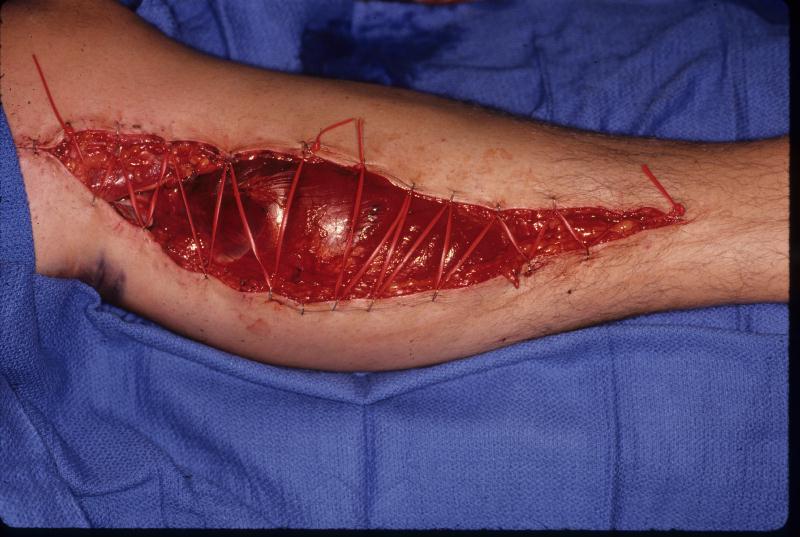How to heal a wound
In the event of any injury or possible contact with disease, it is best not to panic. When we panic, our blood pumps faster, we sweat more and thereby produce and use more energy.
The more tired and slow we become, the more we panic. Therefore, when injured, it is best to slow down because this stops you from panicking and possibly doing more harm to yourself.
Although open wounds are a serious concern in a hostile environment, the risks are not only that tissue damage and blood loss could impact on your well-being, but that the wound could become infected. This infection can be caused by bacteria on the object that made the wound, or other foreign material and dirt that might touch the wound.
In one reported incident, an army patrol was operating in a location in theMiddle Eastduring a local insurgency. The patrol was briefed that no mercy would be spared if any of the members were captured. Should any of them be wounded, the patrol was ordered to leave them behind.
As the patrol moved into its area of operations (very much a hostile environment), contact was made with the enemy, shots were fired and one of the men was seriously wounded. Based on their orders, the patrol left the man and informed him that they would return in a couple of days to escort him out of the area. The wounded man accepted the order and prepared himself for self-surgery. However, shortly after the patrol moved on, the man passed out for two days. After regaining consciousness, he noted that his wound was covered in flies. In fact, they were blue bottles and on brushing them off, he found his wound had many maggots under below the pus.
His training had told him how to heal such a wound, so the soldier boiled some of his water and cleaned the wound infection. Next, he burned one of his field dressings, placed it in the cleaned wound and wrapped it up with one of his other bandages. The burnt bandage was completely sterile and prevented further wound infection, thereby saving his life.
Whilst you might be exposed to wounds caused by shrapnel, mines, bullets, knives or other lethal objects, you need to remember that there are two processes to follow to heal a wound.
If you have an open wound, it is better to leave it open, and allow the drainage of any pus resulting from infection. As long as the wound can drain, it will not become life-threatening, despite how it looks or smells. Cover the wound with a clean dressing and place a bandage on the dressing to hold it in place. Change this dressing daily and check for infection.
If the wound is gaping, you can bring the edges together by cutting duct tape or plasters into a dumbbell or butterfly shape.
If you have antibiotic or antimicrobial cream with you, then you can adopt a more hygienic approach. Clean your hand first, and then clean your wound with water that has been sterilized with purification tablets or potassium permanganate. You can fill a plastic bag with water, once you have made a small hole on it. Squeeze the water bag to wash out the wound. Remove any other debris with sterilized tweezers. When the wound is clean, add the antibiotic or antimicrobial cream to the dressing and cover the wound.
If you do not have antibiotics and the wound becomes severely infected, consider the maggot therapy used by the wounded soldier in the story above.
In this instance, you can expose your wound to flies or blue bottles for one day and then cover the wound. Keep the wound covered once maggots have appeared and wait until you feel a tingling sensation. At this point, the necrotic flesh would have been consumed and you can wash out the maggots with sterile water or fresh urine. Next, bandage the wound and witness the various phases of wound healing until you are satisfied that the wound infection has disappeared.
To maintain health in a Hostile Environment, you must consider the hygiene cycle. The hygiene cycle involves understanding the phases of infection, protection, prevention and source removal.
However, you might not be able to witness or participate in the complete hygiene cycle, but you should know some simple field medicine that will enable you to maintain and practice proper hygiene.
Bird feathers can be used to clean out wounds, clear blocked throats, clean the eyes or as a throat tickler to induce vomiting in cases of poisoning. The oil of coconuts and other nuts can be used as prevention against sunburn. The nut oils can also be extracted by grinding nuts and the oil used for cooking or baking.
Soap can be made from animal fat, fruit, nuts and oils. By melting down the animal fat or grinding the oil from the nuts, you then mix in burnt wood, crushed bone and plant roots. These elements work as an alkaline on the fat and make field soap. Filter this soap through ash or straw and collect the residue in a container.
If you are near the coast, very hot saltwater is ideal for bathing your feet and treating small cuts and abrasions. However, apply saltwater and do not ingest it to induce vomiting.



